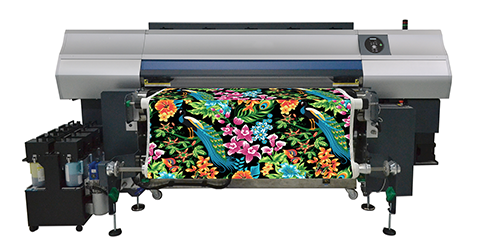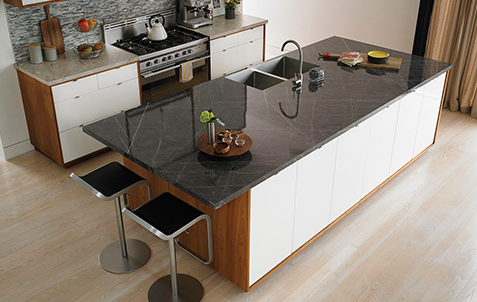Ink options
One of the other challenges is choosing an ink technology. Toscano cites his own reasons for choosing latex over
dye sublimation.
“Dye sub achieves excellent results, but is a very long process,” says Toscano. “We looked at our own production cycle, where we’re creating textile graphics for more than 200 events per year, and realized we had to go with latex.”
Ken VanHorn, director of marketing and business development for wide-format inkjet printer manufacturer Mimaki, speaks to the benefits of dye sub.
“For most indoor applications, it’s really the way to go,” he says. “With a grand-format printer, you can do everything from wallcoverings and shower curtains to pillows and upholstery to bed sheets and ceiling tiles. And the process is getting easier as inks are better-integrated with printers. Before, you had to buy inks and printers from different companies and put them all together yourself, with no warranty. There’s still some ‘mystique’ to dye sub and a need for education, but it’s not hard.”
That said, VanHorn also sees a role for latex and ultraviolet-curable (UV-curable) inks, particularly in wallcoverings.

Some printers use a ‘sticky belt’ drive system to ensure stable handling of fabrics that have a tendency to stretch. Photo courtesy Mimaki
“A variety of technologies can serve the interior décor market, depending which you have at your disposal, and that’s the exciting part,” he says. “As quality standards are evolving, it’s still like the ‘wild west’ out there.”
Windows of opportunity
Key developments in new materials have also helped foster growth in customizable interior décor. There has been rich experimentation in window films, for example, that can be applied to room partitions and other architectural elements.
“There are different kinds of window films for solar control, safety, privacy, graphics and other purposes,” says Peter Yates, owner and president of Window Film Systems (WFS) in London, Ont. “While we’ve always distributed films that could be printed on, in the past those with a scratch-resistant coating could not receive inks. That changed around 2002, when manufacturers started providing clear, scratch-resistant polyester films that could be printed with graphics.”
Yates explains these films tend to be printed with UV-curable inks, but latex is also starting to have an impact on the market.

Formica Group prints patterned graphics on laminates for interior décor surfaces. Photo courtesy Formica Group
“A lack of solvents is definitely a selling feature for interior décor,” he says. “Also, optical clarity carries a high value for these applications. That can’t be achieved with vinyl; you need polyester.”
Like Formica Group’s laminates, WFS also offers preprinted patterns like wood grains and marble finishes.
“A lot of people are interested in these patterns for walls and ceilings, not just glass surfaces,” says Yates. “While the majority of our work is still in window films, we’re also covering reception desks and other furniture.”
As such, Yates highlights the potential of converting interior surfaces throughout an entire office building, compared to simply providing a few high-impact window graphics.
“Interior design is big business, but it’s a very different world from signage,” he says. “You need a slower-sell approach. We have a graphic designer on staff who helps architects implement these kinds of jobs. You have to become a design shop, not just a production shop.”
With files from ESMA, HP Canada, Global Printing, Formica Group, Mimaki and WFS. For more information, visit www.esma.com, www.hp.com, www.globalprinting.ca, www.formica.com, www.mimakiusa.com and www.windowfilmsystems.com.





